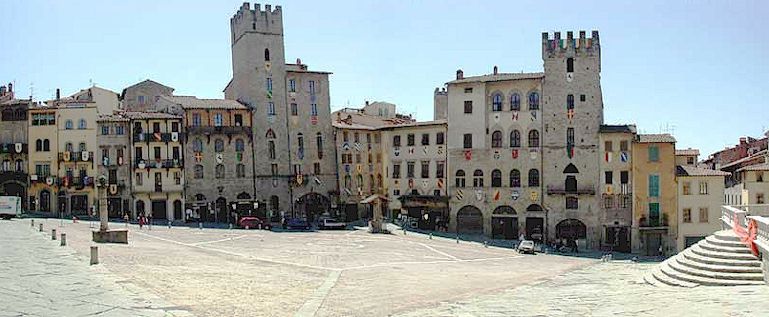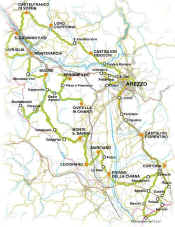

|
Considering
how small it is even to this day, the contribution of Arezzo
to Western Civilisation
has been little short of astounding. Here we outline some of the attractions,
sights and events of interest to visitors to Arezzo.
Arezzo is set on a steep hill rising from the floodplain of the Arno. In the upper part of the town are the cathedral, the town hall and the
Medici Fortress (Fortezza Medicea), from which the main streets branch off towards the lower part as far as the gates. The upper part of the town maintains its
mediaeval aspect despite the addition of later structures.
Arezzo antiques and flea marketThe Arezzo antiques market, Fiera Antiquaria, takes place over the weekend that includes the first Sunday of each month and is one of the best in Italy, with over 500 dealers when the weather is good. (Note that it is the first Sunday of the month, not the first weekend). Booths are set up throughout the upper area of the city from the Basilica of San Francesco past the duomo and sell antiques, paintings, jewelry, sculpture, crèche figures, prints and silver ex-votos.
|
Arezzo antiques market, Fiera Antiquaria
|

Click
the map for a larger location map of Arezzo.
|
History of ArezzoArezzo may have been one of the twelve most important Etruscan cities, the Etruscan Dodecapolis. It was described by Livy as one of the Capitae Etruriae (chief Etruscan cities). Etruscan remains establish that the acropolis of San Cornelio, a small hill next to that of San Donato, was occupied and fortified in the Etruscan period. There is other significant Etruscan evidence, parts of walls, an Etruscan necropolis on Poggio del Sole (still named "Hill of the Sun" ), and most famously, the two bronzes, the "Chimera of Arezzo" (5th century BC) and the "Minerva" (4th century BC) which were discovered in the 16 C and taken to Florence. Increasing trade connections with Greece also brought some elite goods to the Etruscan nobles of Arezzo: the krater painted by Euphronios ca 510 BCE with a battle against Amazons (in the Museo Civico) is unsurpassed.
Arretium was conquered by the Romans in 311 BC and became a military station on the via Cassia, the road to expansion by republican Rome into the basin of the Po. Arretium sided with Marius in the Roman Civil War, and the victorious Sulla
established a colony of his veterans in the half-demolished city, as Arretium Fidens ("Faithful Arretium"). The old Etruscan aristocracy was not extinguished: Caius Clinius Mecaenas, whose name is eponymous with "patron of the arts", was of the noble Aretine Etruscan stock. The city continued to flourish as Arretium Vetus ("Old Arretium"), the third largest city in Italy in the Augustan period, well-known in particular for its widely-exported pottery, the characteristic moulded and glazed Arretine ware, bucchero-ware of dark clay, and red-painted vases (the so-called "coral" vases). |
Arezzo - the main sightsArezzo Piazza Grande
The Piazza Grande is the most noteworthy mediaeval square in the city, opening behind the
13 C Romanesque apse of S. Maria della Pieve. Once the main marketplace of the city, it is currently the site of the
Giostra del Saracino ("Joust of the Saracin"). It has a sloping pavement in red brick with limestone geometrical lines. Aside from the apse of the church, other landmarks of the square include: Arezzo Churches
• Cathedral of San Donato
(gothic, 13 C - early 16 C). The façade remained unfinished, and was added in the
20 C. The interior has a nave and aisles divided by massive pilasters. The left aisle has a fresco by
Piero della Francesca portraying Mary Magdelene. The
mediaeval stained glass, the Tarlati Chapel (1334) and the Gothic tomb of Pope Gregory
X are all worth seeking out. Other monuments and places of interest in Arezzo
•
Palazzo dei Priori, erected in 1333, has been the seat of the city's magistratures until today. The
structure has been restored and renovated frequently. The interior has a courtyard from the
16 C, a stone statue portraying a Madonna with Child (1339), frescoes, busts of illustrious Aretines, two paintings by Giorgio Vasari. The square tower
dates from 1337. Festivals at ArezzoGiostra del SaracinoArezzo is home to an annual mediaeval festival called the Joust of the Saracen (Giostra del Saracino) held twice a year, a night version on the third Saturday in June and the second on the first Sunday in September. In this joust, "knights" on horseback representing different areas of the town charge at a wooden target attached to a carving of a Saracen king and score points according to accuracy. Virtually all the town's people dress-up in mediaeval costume and enthusiastically cheer on the competitors.
Joust of the Saracen (Giostra del Saracino)
Arezzo WaveArezzo is also home to an annual popular music and culture festival, each July, called Arezzo Wave. The Arezzo Wave festival is publicly funded and attracts bands of high repute and attendees from all over Europe and North America. It also features literary and film expositions. |
|
Arezzo
©
ammonet InfoTech
2006 - 2022